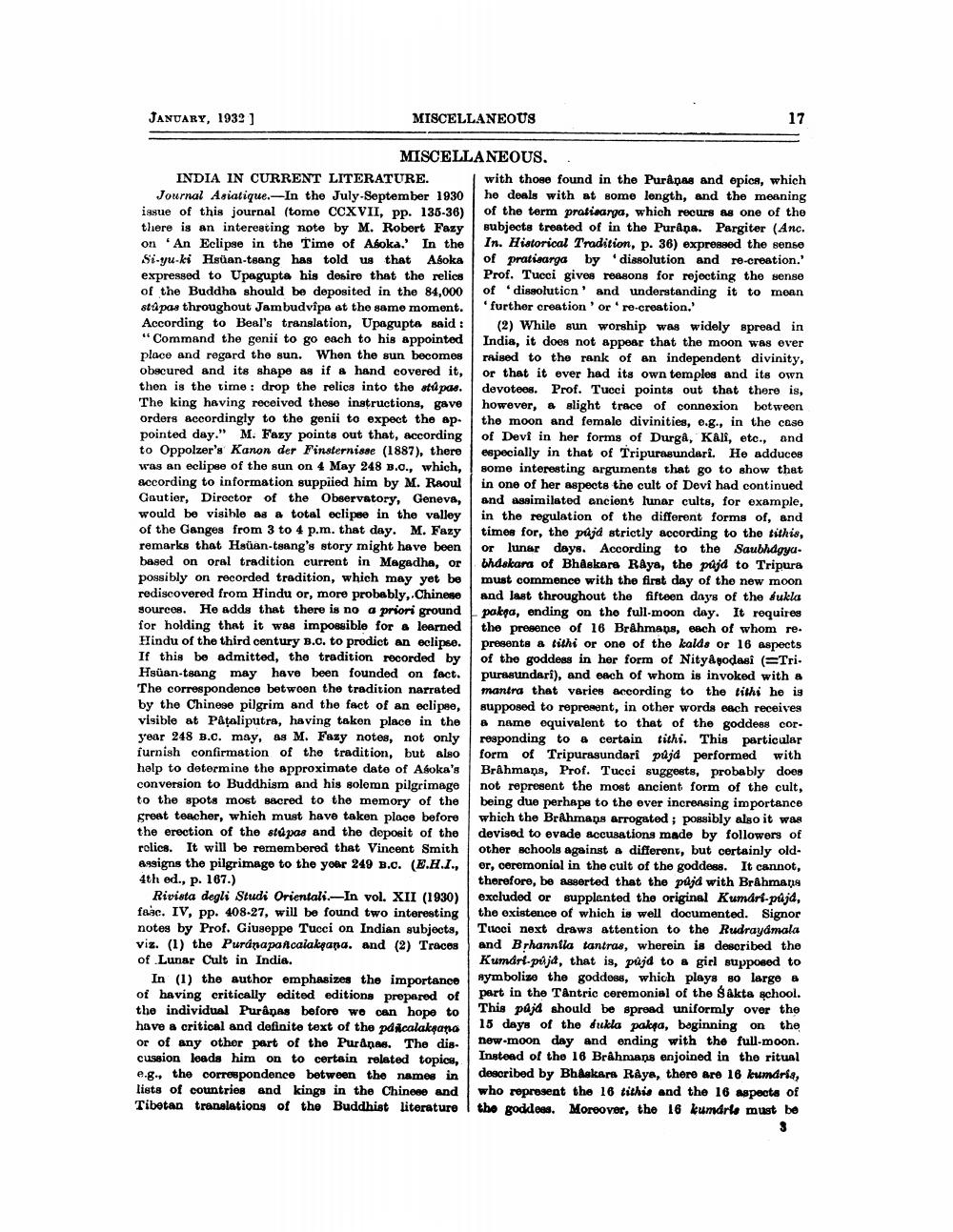________________
JANUARY, 1932 ]
MISCELLANEOUS
MISCELLANEOUS INDIA IN CURRENT LITERATURE. with those found in the Puranas and opica, which Journal Asiatique.- In the July-September 1930 he deals with at some length, and the meaning issue of this journal (tome CCXVII, pp. 135-36) of the term pratisarga, which recurs as one of the there is an interesting note by M. Robert Fazy | subjects treated of in the Purana. Pargiter (Anc. on 'An Eclipse in the Time of Asoka.' In the In. Historical Tradition, p. 36) expressed the sense Si-yu-ki Hsuan teang has told us that Asoka of pratisarga by 'dissolution and re-creation.' expressed to Upagupta his desire that the relics Prof. Tucci gives reasons for rejecting the sense of the Buddha should be deposited in the 84,000 of 'dissolution' and understanding it to mean stá pas throughout Jambudvipa at the same moment. 'further creation or re-creation.' According to Beal's translation, Upagupta said : (2) While sun worship was widely spread in "Command the genii to go each to his appointed India, it does not appear that the moon was ever place and regard the sun. When the sun becomes raised to the rank of an independent divinity, obscured and its shape as if & hand covered it, or that it ever had its own temples and its own then is the time : drop the relics into the stúpas. devotees. Prof. Tucci points out that there is, The king having received these instructions, gave however, & slight trace of connexion between orders accordingly to the genii to expect the ap. the moon and female divinities, e.g., in the case pointed day." M. Fazy points out that, according of Devi in her forms of Durga, Kal, etc., and to Oppolzer's Kanon der Finsternisse (1887), there especially in that of Tripurasundari. He adduces was an eclipse of the sun on 4 May 248 B.O., which, some interesting arguments that go to show that according to information suppiied him by M. Raoul in one of her aspects the cult of Devi had continued Cautier, Director of the Observatory, Geneva, and assimilatod ancient lunar culte, for example, would be visible as a total eclipse in the valley in the regulation of the different forms of, and of the Ganges from 3 to 4 p.m. that day. M. Fazy times for, the půjd strictly according to the tithis, remarks that Hsüan-tsang's story might have been or lunar days. According to the Saubhdgyu. based on oral tradition current in Magadha, or bhdskara of Bhdekara Raya, the půjd to Tripura possibly on recorded tradition, which may yet be must commence with the first day of the new moon rodiscovered from Hindu or, more probably, Chinese and last throughout the fifteen days of the Wukla sources. He adds that there is no a priori ground pakpa, ending on the full-moon day. It requires for holding that it was impossible for a learned the presence of 16 Brahmaps, each of whom re. Hindu of the third century B.c. to prodict an eclipse. presents a tithi or one of the kalds or 16 aspects If this be admitted, the tradition recorded by of the goddess in her form of Nityapodasi (=Tri. Hsuan-taong may have been founded on fact. purasundari), and each of whom is invoked with a The correspondence betwoen the tradition narrated mantra that varies according to the lithi he is by the Chinese pilgrim and the fact of an eclipse, supposed to represent, in other words each receives visible at Påtaliputra, having taken place in the & nemo equivalent to that of the goddess cor. year 248 B.C. may, as M. Fazy notes, not only responding to a certain tithi. This particular furnish confirmation of the tradition, but also form of Tripurasundari půjd performed with help to determine the approximate date of Asoka's Brahmans, Prof. Tucci suggests, probably does conversion to Buddhism and his solemn pilgrimage not represent the most ancient form of the cult, to the spots most sacred to the memory of the being due perhape to the ever increasing importance great teacher, which must have taken place before which the BrAhmans arrogated; possibly also it was the erection of the stúpas and the deposit of the devised to evade accusations made by followers of rolics. It will be remembered that Vincent Smith other schools against a different, but certainly old89signs the pilgrimage to the yobr 249 B.C. (E.H.I., er, ceremonial in the cult of the goddess. It cannot, 4th ed., p. 167.)
therefore, be asserted that the půjd with BrAhmans Rivista degli Studi Orientali.-In vol. XII (1930) excluded or supplented the original Kumdri-pájd, fasc. IV, pp. 408-27, will be found two interesting the existence of which is well documented. Signor notes by Prof. Giuseppe Tucci on Indian subjects, Tuoci next draws attention to the Rudrayamala viz. (1) the Purdnapancaiakpana. and (2) Traces and Brhannila tantras, wherein is described the of Lunar Cult in India.
Kumári-puja, that is, půjd to a girl supposed to In (1) the author emphasizes the importance
symbolize the goddess, which plays so large a of having critically edited editions prepared of part in the Tántric ceremonial of the Sakta school. the individual Puranas before wo can hope to
This půjd should be spread uniformly over the have a critical and definite text of the pdicalaksana
15 days of the drikla pakpa, beginning on the or of any other part of the Puranas. The dis
new-moon day and ending with the full-moon. cussion loads him on to certain related topics, Instead of the 16 Brahmans enjoined in the ritual e.g.. the correspondence between the names in described by Bhaskara Raya, there are 16 kundria, lists of countries and kings in the Chinese and who represent the 16 tithis and the 16 aspects of Tibetan translations of the Buddhist literature the goddess. Moreover, the 16 kundrlo must be




